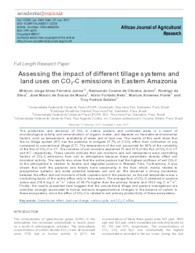Assessing the impact of different tillage systems and land uses on CO2-C emissions in Eastern Amazonia.
Assessing the impact of different tillage systems and land uses on CO2-C emissions in Eastern Amazonia.
Autoria: FERREIRA JUNIOR, M. J. A.; OLIVEIRA JUNIOR, R. C. de; SILVA, R. da; MOURA, J. M. de S. de; FURTADO NETO, A.; PONTE, M. X.; BELDINI, T. P.
Resumo: The production and emission of CO2 in native, pasture and cultivated areas is a result of microbiological activity and mineralization of organic matter, and depends on favorable environmental factors, such as temperature, availability of water and of land use. The results of this work show that the no tillage system (NT) has the potential to mitigate 37.7% of C-CO2 efflux from cultivation of soy compared to conventional tillage (CT). The temperature of the soil accounted for 65% of the variability of the flux of CO2-C in CT. The variation of soil moisture explained 73 and 51% of the flux of CO2-C in CT and NT, respectively. These results indicate that soil moisture and soil temperature were controlling factors of CO2-C emissions from soil to atmosphere because these parameters directly affect soil microbial activity. The results also show that the active pasture had the highest outflows of soil CO2-C to the atmosphere in relation to forests and degraded pasture in Western Pará. Furthermore, it was shown that both the pastures and forests have seasonality in the fluw, which mainly related to precipitation patterns and water potential between soil and air. We observed a strong correlation between the efflux and soil moisture of both capoeira and in the pastures, as the soil temperature was a controlling factor of the active efflux only in the pasture. The average fluw of CO2-C obtained in pasture active was 218.9 mg C m-2 h-1 value of 40.7% higher than the primary forests and 155.5 mg C m-2 h-1. Finally, the results presented here suggest that the conventional tillage and pasture management are activities strongly associated to human enhance biogeochemical changes in the balance of carbon in these ecosystems, since the efflux of CO2-C is related to soil primary productivity of these ecosystems.
Ano de publicação: 2017
Tipo de publicação: Artigo de periódico
Unidade: Embrapa Amazônia Oriental
Palavras-chave: Carbono, Efeito Estufa, Uso do solo
Observações
1 - Por padrão são exibidas publicações dos últimos 20 anos. Para encontrar publicações mais antigas, configure o filtro ano de publicação, colocando o ano a partir do qual você deseja encontrar publicações. O filtro está na coluna da esquerda na busca acima.
2 - Para ler algumas publicações da Embrapa (apenas as que estão em formato ePub), é necessário ter, no celular ou computador, um desses softwares gratuitos. Sistemas Android: Google Play Livros; IOS: iBooks; Windows e Linux: software Calibre.
Acesse outras publicações
Acesse a Base de Dados da Pesquisa Agropecuária (BDPA) para consultar o acervo completo das bibliotecas da Embrapa.

